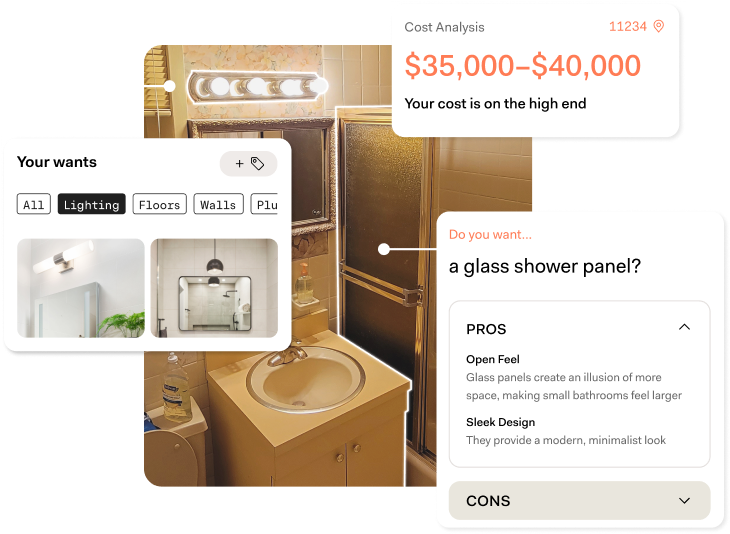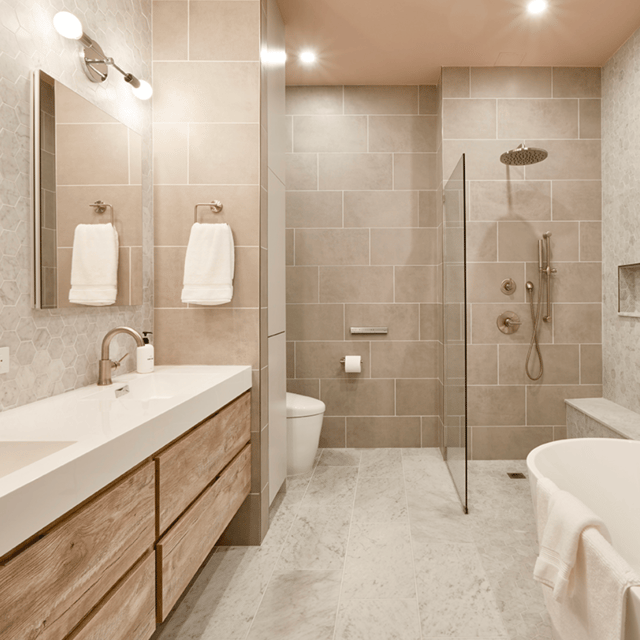
Bathroom
Eco-Friendly Shower & Bathroom Ideas
12.23.2025
Our New Year savings event is here: Get up to $6,500 off your project today (terms apply).


In This Article
Ready to give your bathroom a makeover that feels like a mini-retreat? The right paint can do wonders, transforming even the most mundane spaces into spa-like sanctuaries or vibrant personal oases. But with countless shades, finishes, and brands to choose from, picking the perfect one can be a daunting task. It's not just about choosing a pretty color—it’s about selecting a paint that can withstand the unique challenges of a bathroom environment.
So, before you grab that paintbrush, let’s break down what you need to know to make your bathroom not just beautiful, but also durable and easy to maintain. From the perfect finishes to the trendiest colors, we’re here to guide you through the process so your bathroom can shine in more ways than one.
When we talk about a paint’s finish, we’re referring to the level of sheen—or how much light the painted surface reflects—once the paint has dried. The finish not only affects the look of the paint but also its durability, ease of cleaning, and suitability for different environments.
|
Finish |
Sheen Level |
Durability |
Moisture Resistance |
Ease of Cleaning |
Best Uses in a Bathroom |
|
Flat (Matte) |
No sheen |
Low |
Poor |
Low |
Rarely recommended; may be used on ceilings in low-moisture areas |
|
Eggshell |
Low sheen |
Moderate |
Fair |
Moderate |
Low-moisture walls or powder rooms |
|
Satin |
Soft sheen |
High |
Good |
High |
Bathroom walls; balances style and durability |
|
Semi-Gloss |
Noticeable sheen |
Very High |
Excellent |
Very High |
Bathroom walls, trim, doors, and cabinetry |
|
Gloss (High-Gloss) |
High shine |
Maximum |
Excellent |
Maximum |
Trim, doors, and accent features; not ideal for large wall areas |
Selecting the right bathroom paint finish and color isn’t just about style—it’s about protecting your space and ensuring it looks great for years to come. Bathrooms face unique challenges due to constant moisture, temperature changes, and frequent cleaning. The wrong choice can lead to peeling, staining, or mold growth, while the right one can keep your walls looking fresh and beautiful.

Here’s why your paint choice matters:
In short, the right combination of bathroom paint finish and color not only elevates your bathroom’s style but also ensures it can withstand the daily wear and tear of a high-moisture space. Take the time to choose your gloss and tints wisely!

On the other hand, if you prefer a warm, cozy vibe, warm beiges and creamy neutrals can create an inviting, homey feel that’s versatile enough to work with any décor. But don’t shy away from making a bold statement either—deep navies, bold reds, or even a moody forest green can add a touch of drama and sophistication, transforming your bathroom into a stylish retreat.
Remember, the right combination of finish and color not only enhances your bathroom’s aesthetic appeal but also ensures it stands up to the daily wear and tear that bathrooms endure. So, take your time, explore your options, and choose a finish and color that will make your bathroom truly shine.
Learn More: The Complete Guide to Home Painting Costs in 2024: Interiors & House Exteriors
Selecting the right bathroom paint finish and color isn’t just about style—it’s about protecting your space and ensuring it looks great for years to come. Bathrooms present demanding environmental conditions, with persistent humidity, fluctuating temperatures, and frequent cleaning that can quickly degrade inferior paint finishes. The wrong finish can lead to peeling, staining, or mold growth, while the right one can keep your walls looking fresh and beautiful.
Example of what works: Semi-gloss paint brings a polished, modern shine that brightens up any bathroom, while satin offers a softer, more understated glow. Both finishes are tough enough to handle steamy showers and splash zones, ensuring your bathroom stays as stylish as it is practical. So, before you pick your paint, make sure the finish is up to the challenge—because in a bathroom, it’s not just about looking good; it’s about lasting long.
Example of what doesn't work: Flat and eggshell paint finishes might look chic in other rooms, but they’re a recipe for disaster in a bathroom. These finishes are porous, meaning they can trap moisture, leading to mold growth, peeling, and even water damage.

Good news—there are mold-resistant paint finishes designed to offer superior protection in moisture-prone bathrooms. Specially formulated with antimicrobial agents, these bathroom-friendly finishes inhibit the growth of mold and mildew, helping to maintain a cleaner, healthier environment. Their durable, non-porous surface makes it difficult for spores to take hold, even in high-humidity conditions where moisture lingers. Ideal for bathrooms, laundry rooms, and other damp spaces, mold-resistant finishes combine long-term protection with a polished, professional appearance.

Want a mirror-like shine that exudes modern elegance? If yes, high gloss paint finishes are the ideal answer for your bathroom. They’re incredibly durable and super easy to clean, making them ideal for bathrooms that see a lot of action. The high shine can reflect light beautifully, making even the smallest bathrooms feel more spacious. Just be aware—high gloss can also highlight every little imperfection on your walls, so make sure your surfaces are smooth and ready to shine.
Semi-gloss finishes strike the perfect balance between beauty and durability. They have just enough shine to make your bathroom feel bright and fresh without being overly reflective. Plus, they’re tough enough to stand up to daily splashes and steam and a breeze to wipe down when needed. Semi-gloss is a go-to for bathrooms because it offers that sweet spot between style and practicality.

For a softer, more elegant look, satin paint is the way to go. It offers a subtle sheen that adds warmth and depth to your bathroom without overpowering the space. While it’s not as shiny as semi-gloss, satin is still resistant to moisture and easy to clean, making it a solid choice for a bathroom that needs both style and substance. If you’re looking for a versatile and timeless finish, satin has you covered.
Learn More: What Color Should You Paint A Black And White Tiled Bathroom
Not all paint finishes are created equal, especially when it comes to bathrooms. In a space where moisture and humidity are a constant battle, some finishes just can’t hold up. While they might look great in other rooms, these particular finishes can spell trouble in your bathroom, leading to mold, mildew, and peeling issues. Let’s take a closer look at the paint finishes you should steer clear of when sprucing up your bathroom.
Matte finishes might be trendy, but they’re not bathroom-friendly. Their lack of sheen makes them more prone to absorbing moisture, which can lead to unsightly water stains and even bubbling. Plus, they’re harder to clean, so any splash or smudge will likely stick around longer than you’d like. Save matte finishes for low-moisture areas where they can shine without the risk of getting damp.
Flat paint finishes offer a smooth, non-reflective surface that works wonders in bedrooms and living rooms, but they’re a no-go in bathrooms. These finishes are highly porous, meaning they can easily trap moisture, which leads to peeling paint and mold growth over time. If you want your bathroom walls to stay intact and look fresh, flat paint finishes are best left out of the equation.
Eggshell finishes provide a soft, velvety look that is popular in many homes, but they’re not the best choice for bathrooms. Like matte and flat finishes, eggshells are more prone to absorbing moisture, which can cause the paint to break down faster in a damp environment. While it’s a great option for areas with less humidity, using it in a bathroom could mean frequent touch-ups or even a complete repaint sooner than you’d like.

Choosing the right color for your bathroom can set the tone for your entire day. Whether you’re going for a calming retreat or a bold statement, the color you choose can make all the difference. Some shades can transform a bathroom into a timeless space, while others add a modern touch that's anything but ordinary. Let’s dive into some top color picks that look great and elevate your bathroom’s overall vibe. Whether you’re a fan of crisp whites, cozy beiges, sleek grays, or dramatic blacks, there’s a perfect hue out there waiting to make your bathroom shine.
“Bathrooms set the stage for the beginning and end of your day. Seeing your face and clothes in their true colors provides context. That’s why I prefer Simply White, which reflects natural light in bathrooms,” said interior designer Jennifer Jean Morris to The Spruce. “A white room keeps things feeling fresh, but the warm undertone ensures that it doesn’t feel sterile.”
“Patches by PPG is a rich brown-gray that’s a great darker neutral,” said interior designer Leanne Ford to Hunker. “It is gorgeous alone on the walls with a clean white trim, and it lives well with any metallic hardware. Other natural colors and materials such as wood flooring also coordinate well with this hue.”
“I love bathroom stones that have clean whites and light grays in them. I like to pair that with a light gray paint color, like Benjamin Moore’s Stonington Gray, to pull that color onto the walls,” said Lauren Behfarin of Lauren Behfarin Design to Elle Decor. “It’s a crisp way of keeping things neutral but tying it all together.”
“My favorite bathroom color is Farrow & Ball Off-Black,” said interior designer Tali Roth to MyDomaine. “I love a dramatic black bathroom with a penny round mirror! I think black or a dark moody color is great—particularly when you can’t update the finishes, as it adds drama.”
Not sure if your bathroom walls would look best in a soft, airy lavender or a bold, saturated plum? Choosing the right bathroom paint colors—and the best bathroom paint finish to go with them—can feel overwhelming. That’s why Block Renovation offers three free online tools to help you plan your remodel, narrow your color palette, and visualize every detail of your design before you commit.
Renovation Studio - Think of the Renovation Studio as your all-in-one bathroom design assistant. Upload a photo of your space, answer a few quick questions about your style and goals, and instantly receive personalized design recommendations. You’ll see realistic renderings of your updated bathroom alongside real-time budget estimates, allowing you to explore different layouts, paint finishes for bathroom walls, and fixtures with complete transparency. Whether you’re deciding between satin or semi-gloss for the best sheen for bathroom walls, this tool helps you make informed, confident choices.
Bathroom Visualizer Tool - This free tool lets you experiment with every design detail before committing. Test different tile patterns, vanity styles, fixtures, and paint finishes for bathroom walls in a realistic, interactive environment. Compare how a satin finish versus a semi-gloss finish changes the look, and see how various bathroom paint colors interact with your chosen materials.
Paint Color Picker - With the Paint Color Picker, you can upload any image—whether it’s a vacation photo or fabric swatch—and our AI will instantly identify the exact paint shades. You’ll also receive curated suggestions for complementary and triadic colors from top paint brands, making it easy to create a cohesive, designer-quality palette for your bathroom.

A bathroom renovation is only as good as the professional behind it—which is why Block Renovation works exclusively with pre-vetted bathroom remodelers. Every contractor in our network is thoroughly screened for licensing, insurance, craftsmanship, and a proven track record of successful bathroom projects. We handpick specialists who understand the unique demands of high-humidity spaces, from selecting the best bathroom paint finish to installing moisture-resistant materials. By ensuring you work only with trusted, experienced professionals, we remove the guesswork and give you confidence that your bathroom will be completed to the highest standard—on time and on budget.
Not sure how to begin your renovation?
Get free, expert guidance from a dedicated Block Project Planner who can help you navigate proposals, timelines, contractor selection, and more.
Book A Free Consultation

Written by Block Renovation
What is the difference between satin and semi-gloss finishes?
How do you prevent mold and mildew on bathroom paint?
Can you use regular paint in a bathroom?
How often should you repaint your bathroom?
Does the finish impact the cost of the paint for the bathroom?
Do the recommended finish levels change if painting a half bath?
Yes. In a half bath (powder room) without a shower or tub, moisture levels are much lower, so you have more flexibility in your choice of finish. While satin or semi-gloss is still a safe choice for durability and easy cleaning, you could also use an eggshell finish for a softer look since the risk of moisture damage is minimal. However, if the half bath is heavily used or prone to splashes, sticking with a moisture-resistant finish is still recommended. For more tips on planning and designing a half bath, see our guide on the cost to add a half bath and how to plan for it.

Calculate the true cost of your bathroom remodel
Get real-time cost estimates for materials and labor, so you can budget your renovation with confidence—no guesswork.
Thousands of homeowners have renovated with Block

4.5 Stars (100+)

4.7 Stars (100+)

4.5 Stars (75+)

Bathroom
Eco-Friendly Shower & Bathroom Ideas
12.23.2025

Design
Converting a Closet Into a Mudroom - Here's What to Know
12.21.2025

Paint & Color
Gray Floors? Here's What Paint Colors Will Flatter Your Walls
12.06.2025

Bathroom
New York City Bathroom Remodels: Planning & Renovation Tips
12.05.2025

Bathroom
Slanted Roof Bathrooms and Shower Design Ideas
11.22.2025
Renovate confidently